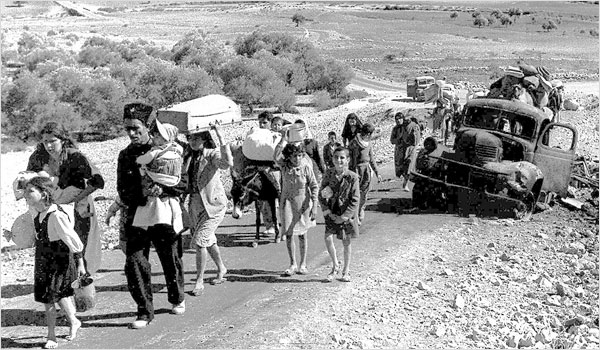
The Hundred Years’ War on Palestine: A History of Settler Colonialism and Resistance 1917–2017, Rashid Khalidi, Metropolitan Books, New York, 2020

The Hundred Years’ War on Palestine tells the story of Rashid Khalidi’s distinguished and scholarly Palestinian family and the story of a century of war against the Palestinian people.1
Khalidi’s great-great-great uncle, Yusuf Diya al-Din Pasha al-Khalidi, was part of a family of Islamic religious scholars. He was an Ottoman government official and mayor of Jerusalem for nearly a decade. As mayor, he witnessed “friction with the local population prompted by the first years of proto-Zionist activity, starting with the arrival of the earliest European Jewish settlers in the late 1870s and early 1880s” (4).
In 1899 Yusuf Diya wrote to Viennese journalist Theodor Herzl, author of Der Judenstaat and leader of the Zionist movement. He kindly expressed admiration for Herzl, respect for “Judaism and Jews,” and outrage at the persecution of European Jews. But he foresaw the Zionist ambitions regarding Palestine, so he reminded Herzl that Palestine “is inhabited by others” and ended his letter with a plea for his home and people: “In the name of God, let Palestine be left alone” (5).
Herzl’s 1895 diary entry reveals his Zionist plan for ethnic cleansing in Palestine: “We shall try to spirit the penniless population across the border. . . . The property owners will come over to our side. Both the process of expropriation and the removal of the poor must be carried out discreetly” (4). In his letter of reply to Yusuf Diya, Herzl was contemptuous and dismissive of the Palestinian people, referring to them only as what they were not: “the non-Jewish population.” The Palestinians were then 95% of the population but, to Herzl, they did not merit recognition as a people with an identity, a culture, nationalist aspirations, and ancient ties to their land. Yusuf Diya was a prescient and prominent figure in Palestinian society in 1899, but Herzl lied to him about Zionism’s true intentions regarding Palestinians: “Who would think of sending them away?” (7).
The letters between Yusuf Diya and Theodor Herzl were probably “the first meaningful exchange between a leading Palestinian figure and a founder of the Zionist movement” (8). And this 1899 exchange established a pattern, from Herzl to Trump, of “dismissing as insignificant the interests, and sometimes the very existence, of the indigenous Palestinian population” (5).
Rashid Khalidi, the Edward Said Professor of Modern Arab Studies at Columbia University and author of The Iron Cage, Brokers of Deceit, and other books on the Middle East, sheds light on six major political and military engagements in the “Hundred Years’ War.” The common thread is the willful refusal of imperialist and Zionist powers to “see” the Palestinian people.
If Herzl’s letter was the opening salvo in this war, the next was the linguistic annihilation in the infamous Balfour Declaration of November 1917. Only one sentence long, the Balfour Declaration, named for Arthur James Balfour, British Secretary of State for Foreign Affairs, gave favor to “the establishment in Palestine of a national home for the Jewish people” with an obligatory caution that no harm shall be done to the “existing non-Jewish communities in Palestine” (24). Again, the Palestinians, as “non-Jewish,” were mentioned only for what they were not. The League of Nations in 1922 embraced the Balfour Declaration “verbatim,” again denying recognition to the Palestinian people so that “only one people in Palestine is to be recognized with national rights: the Jewish people” (34).
The 1947 United Nations partition resolution led to war. And “notwithstanding the widely accepted assertion that the Israeli army was dwarfed by seven invading Arab armies, we know that in 1948 Israel in fact outnumbered and outgunned its opponents” (77). This war “transformed most of Palestine from what it had been for well over a millennium — a majority Arab country — into a Jewish state” (77). Israel used the war to conceal massive ethnic cleansing and “theft of Palestinian land and property left behind by refugees” (77). Professor Khalidi adds, “In the aftermath of the 1948 war, the Palestinians were virtually invisible, hardly covered in the western media and rarely allowed to represent themselves internationally” (88), so that “after 1948, it appeared as if the Palestinians had largely disappeared, both physically and as an idea” (112).
After their military success in the Six Day War, Israel’s leaders were more and more the “ideological heirs of Zeev Jabotinsky, believing that the entirety of Palestine belonged solely to the Jewish people, and that a Palestinian people with national rights did not exist” (136). Jabotinsky was an early Zionist who wrote in 1923: “Every native population in the world resists colonists as long as it has the slightest hope of being able to rid itself of the danger of being colonized” (12). He therefore called for the use of massive force, an “iron wall” of bayonets against the Palestinian people (13).

Israel’s 1982 war in Lebanon against the PLO defeated the Palestinian nationalist movement in neighboring Arab countries, where it had fled after the Six Day War, but paradoxically, led the PLO to take root again within Palestine. And, following the war in Lebanon, a commission of inquiry chaired by an Israeli Supreme Court justice found senior Israeli military and political leaders responsible for a horrible massacre at the Palestinian Sabra and Shatila refugee camps.
The author describes the First Intifada of 1987 as “an outstanding example of popular resistance against oppression” and “the first unmitigated victory for the Palestinians in the long colonial war that began in 1917” (174).
The Second Intifada, beginning in September 2000, led to massive Israeli military incursions into Gaza in 2008, 2012, and 2014 with “savage disproportionality” (227) by Israel and “Israeli forces’ massive use of live ammunition against unarmed demonstrators . . . causing a shocking number of casualties” (213). Telling is the “lopsided 43:1 scale of casualties” as is the fact that “the bulk of the Israelis killed were soldiers while most of the Palestinians were civilians” (222).
Professor Khalidi notes that the Hundred Years’ War on Palestine has been waged, not only with U.S. weaponry but also with imagery and a narrative controlled by Israel. Herzl again led the charge in describing Israel as “an outpost of civilization against barbarism” (11). Israeli hasbara (public relations) includes propaganda such as “a land without a people for a people without a land” and “making the desert bloom.” Israel wrapped its ethnic cleansing, expulsion, and land theft in a “biblical coat” (9) to blind the world to the reality of a colonial settler war against an indigenous people. Palestinians trying to resist theft of their homeland were branded as terrorists because, as Edward Said has written, Zionism “won the political battle for Palestine in the international world” (240). The fact that the words “settler” and “pioneer” are still bathed in a good light in America has made it more difficult for the Palestinian struggle to be honored in Western media (240). Israel has gotten away with portraying itself as a David surrounded by an Arab Goliath, but that is backward, as the Palestinians have historically had to do battle with a Zionist enterprise backed by the political and military muscle “of the great imperial powers, Britain and later the United States” (14). Rashid Khalidi does a beautiful job of correcting the narrative and telling the true story of the Hundred Years’ War, from Herzl’s 1899 letter to Donald Trump’s sleazy Deal of the Century.
The great Palestinian scholar Edward Said said, “They have no use for us. The best Palestinian for them is either dead or gone” (207). The invisibility of the Palestinian people is a reminder of a wretched event in America’s colonial settler war against its Native peoples: 38 Dakota Sioux were the victims of the largest mass execution in American history in the early morning hours of December 26, 1862, at Mankato, Minnesota. The original death order from the military tribunal bore 303 names, but President Lincoln, skeptical of the justice of the proceedings, reduced the number to 38. It was a public hanging, with huge gallows built in the shape of a hollow square. The 38 condemned warriors, ranging in age from teens to the elderly, submitted to being bound but rejected hoods as a humiliation. They stood on the gallows, held hands, and repeatedly chanted, “We are here, we are here”.2
Whatever the facts on the ground, the Palestinians are the moral victors in this Hundred Years’ War. Israel, like America, must forever bear the shame of building their nation on stolen land, on the tears of another people. The Palestinians, with their steadfast resistance (sumud in Arabic) and with their refusal to surrender their beloved homeland, continue to tell the world, “We are here, we are here.”
Note
1. The book’s cover photo shows the ruins of a home near Jaffa, the home of the author’s grandfather until taken over by Zionist settlers.
2. The People, vol. 107, no. 7, October 1997, p. 5, “Terror, Genocide Part of U.S. History.”
Images: Top, Montecruz Foto (CC BY-SA 2.0); Palestinian refugees in 1948, Wikipedia.
- Tags:
- book review
- Palestine


 Join Now
Join Now